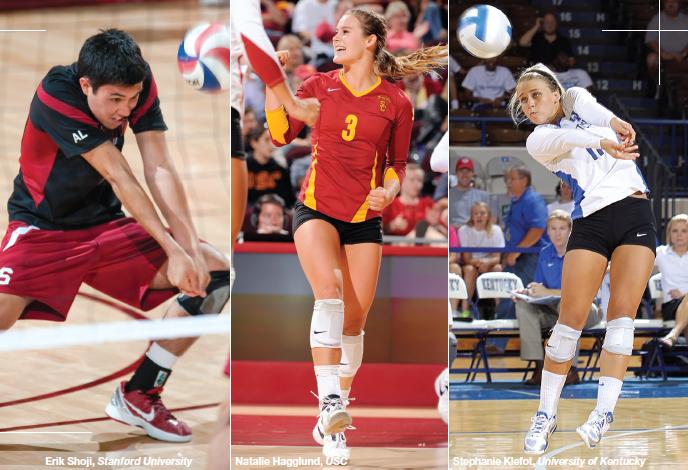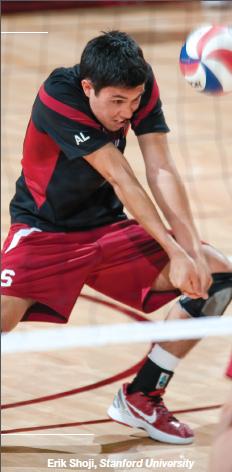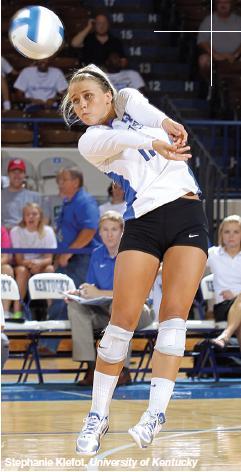| By Jessi Greenberg
Originally Published in Coaching Volleyball Magazine - AVCA
The one consistent trait that I found among elite liberos, according to some ofthe nation's top coaches, is that they must be able to serve receive at an extremely high level. Mick Haley, Head Women's Volleyball Coach at the University of Southern California, explained that it is the libero's job to be the best passer on the court. "Serve receive is the name of the game for liberos. They are out there six times as a primary receiver," said Haley. Most coaches and players would agree that a libero must be a talented serve receiver, but the issue that has become apparent is that, as a community, we are unsure as to how to measure that "talent." According to Haley, there are two main ways to measure serve receive. The first measurement he uses is the 5-point system. This measurement requires a statistician to analyze the quality of pass made by a libero off of a serve. The system ranges from zero to four, zero being an ace, one being a pass far off the net or an overpass, two being a pass where the setter can only set two hitters, three being a pass where the setter can still set three hitters although the pass isn't perfect, and four beinga perfect pass. Most coaches evaluate their passers using either a 5-point or 4-point system, which is similar to a 5-point system, except there is no 4-point pass. In a 4-point system, a perfect pass is deemed a 3-point pass, which is any ball that the setter can set all three hitters. However, the frequent use of these systems doesn't mean they aren't flawed. Statisticians and coaches all have different opinions of what they define as a "perfect pass," making it hard to measure one libero's passing numbers against another's. John Kosty, Head Men's Volleyball Coach at Stanford University, agrees that the passing scale is vital "but you don't know how much you can trust the statistics." Some coaches keep their own statistics, but all too often, statisticians with varying levels of volleyball knowledge are used, thus creating inconsistencies among passing numbers from one team to another. Even with all the potential for error, the 5-point or 4-point systems are still commonly used. Many coaches that use this system, including Haley, look for their players to pass a 2.3 or better on the scale; however, there is another passing statistic that may be even more important in the evaluation of a libero. Obviously, there is more than one way to evaluate the quality of a libero's serve receive, but there are also factors involved that cannot be measured. Dagenais and Haley both agreed that a libero's range must also be taken into account when determining their ability to serve receive. "The range of the libero is not easily kept," said Dagenais. Haley concurred that it is important to look at how much court a libero can cover and how much area they can take away from their teammates. This type of measurement is one of the "intangibles" that make it so difficult to evaluate liberos. Although Kosty coached one of the most statistically talented college liberos ever to play the game in Erik Shoji, he still emphasized the importance of the intangibles. Kosty attributed much of Shoji's talent to his childhood experiences. "He grew up with a family of volleyball players. He grew up watching and analyzing the game with his dad and was able to learn from good players," said Kosty. He also believes Shoji's experience playing tennis made him a better passer because it forced him to move his feet, which helped increase his range as a libero. The list of intangibles that make a successful libero is infinite, and according to Kosty, this is why the position is "the hardest to recruit." Although they may be hard to measure, intangibles may be just as (or perhaps even more) important than statistics when measuring the quality of a libero, depending on whom you ask. Ron Kordes, KIVA Club Director and Head Coach at Assumption High School in Louisville, Kentucky, has coached talented liberos that are now playing at colleges all over the country. He believes that the key to a quality libero comes with a special balance between skills and the intangibles. "Obviously a libero has to have good platform skills and footwork, but from there we always look for a competitor," said Kordes. As far as serve receive goes, Kordes also recognized the importance of range. "I think you can train a lot of people to play defense," he said. "But the exceptional defensive players are the ones that have range and can cover a wide area rather than balls only hit right at them." Haley also has a lot of experience coaching players with a lot of intangibles, including current USC libero Natalie Haglund. "She makes every other player on the court better," said Haley. "It's her energy, her ability to be positive all the time, her intense desire to be successful and never take credit." The qualities that help make an elite libero, such as energy, confidence and positivity, are obviously immeasurable. However, one libero statistic that is commonly used may be even more ambiguous. Teams at every level of volleyball, from high school to college, keep track of the number of "digs" their players get. While this simple statistic may seem a good measure of a libero's talent, it is often misused and overemphasized. "The player that gets a lot of digs isn't necessarily the best defensive player," according to Dagenais. The reasoning behind this theory is that coaches often overlook the quality of the dig. At UCF, Dagenais says they focus more on "quality digs" instead of just digs. A quality dig is unique in that it gives the setter an opportunity create offensive opportunities after the dig is made.
One more recent trend for collegiate and professional liberos is to train them to be the second setter in the game. Because the libero is on the court in every rotation, Kordes thinks it's important to start training his liberos early on to be prepared to set the second ball if the setter is unavailable. This very trait is one of the main reasons Kosty knew Shoji was going to be a special player. In high school, Shoji ran a 6-2 system as a setter, so he already had experience setting when he arrived at Stanford. "I knew he was good because he was the best passer in his age group coming in, but you never know how a player will transition into the college game," said Kosty. While some coaches prefer their liberos to be former setters, Haley has found that outside hitters become some of the best liberos in the game. "When players come from being an outside attacker to specializing as a libero, they know how hitters think," said Haley. "It gives them a unique perspective in how to play their position. Kordes agrees with this philosophy, which is why he trains all his athletes to pass and play defense. "At KIVA we make all our athletes, regardless of their size, go through passing drills," he said. "The kids that are hitting for you at 13 years old will turn out to be your liberos in high school." Clearly, there are a variety of opinions among coaches on how to properly measure the talent of a libero. While some coaches believe the current statistics we have are enough to generate accurate evaluations of liberos, others believe more advances need to be made. Haley believes the 5-point passing system is "statistically valued." According to Haley, the 4-point system didn't provide enough information, and the 6-point system used temporarily in men's volleyball did not have statistical validity. "I think we've got enough material," said Haley, "We just need to use it properly." On the other side of the spectrum, Kosty believes that in order for the passing scale to be relevant on a national level, there needs to be a more definitive way to qualify passing. The main issue he brought up was the inconsistency among statisticians in their definition of a perfect pass. "We can separate liberos statistically for awards" said Kosty, "But if you want to find the best true libero, there needs to be a passer ranking system." Dagenais also believes changes need to be made in the current statistical systems. "4-point systems will become 5-point systems and digs will become dig-to-kill ratios," said Dagenais. Although he thinks that additional research is needed, he doesn't ignore the implications of the numbers. "The statistics are flawed, but they still give you a measurement," he said. "You can't deny that statistics could potentially be a predictor of future success." Whether you believe the current measurements for liberos are adequate or in need of adaptations, the general consensus among coaches is that there is more to the game than numbers. "You can not be held hostage by statistics," said Dagenais. Kordes reiterated this concept saying, "(Statistics) are a great guideline, but not all decisions are made on the best number." Through my experiences as a defensive player, I can safely say that these coaches are on the right track. Trying to compare one libero to the next may be a nearly impossible task because not all coaches are looking for the same qualities in their players. Some coaches will rely heavily on statistics, and some prefer players who bring a more intangible element to the game. There are many questions that can be asked when evaluating the quality of a libero: How do they start the offense? How do they communicate with their team? What confidence do they bring to the rest of the players? But perhaps the most accurate way to measure the quality of a libero is in the success of their team. The measure of any great athlete can be seen in how they affect those around them. A good player may have all the talent in the world, but a great player always finds a way to win. There may not be a number to measure that "it" factor, but it can be seen and felt by anyone in its presence. Michael Jordan had it. John Elway had it. Misty May-Treanor and Kerni Walsh had it too. That unbridled competitive spirit is what truly makes a libero, or any athlete, extraordinary.
|
|
|



 As a former libero and current defensive specialist at the University of Kentucky, I've played with and against liberos from all over the nation. Throughout my career, I've come to realize that there are many characteristics that make up a great libero, some that can be measured and some that can't. Because the libero has become such an integral member of every team, coaches across the country are trying to find the best ways to evaluate their talent.
As a former libero and current defensive specialist at the University of Kentucky, I've played with and against liberos from all over the nation. Throughout my career, I've come to realize that there are many characteristics that make up a great libero, some that can be measured and some that can't. Because the libero has become such an integral member of every team, coaches across the country are trying to find the best ways to evaluate their talent.
 Instead of the simple dig statistic, many coaches are now turning to the "dig-to-kill" statistic, which measures the amount of times the offense is able to terminate the ball after a given dig. "What I'm interested in is how effective we can be on the first ball," says Haley. The dig-to-kill ratio is being used internationally, and may be the most effective statistic we have for measuring the defensive effectiveness of a libero. While flashy defensive plays such as one- handed digs and "pancakes" may be crowd pleasers, Dagenais says he'd rather have balls "20 feet high and 10 feet off the net."
Instead of the simple dig statistic, many coaches are now turning to the "dig-to-kill" statistic, which measures the amount of times the offense is able to terminate the ball after a given dig. "What I'm interested in is how effective we can be on the first ball," says Haley. The dig-to-kill ratio is being used internationally, and may be the most effective statistic we have for measuring the defensive effectiveness of a libero. While flashy defensive plays such as one- handed digs and "pancakes" may be crowd pleasers, Dagenais says he'd rather have balls "20 feet high and 10 feet off the net."


